|
|
|
| My Favourite Planet > English > Europe > Greece > Attica > Athens > galleries > Acropolis |
|
| |
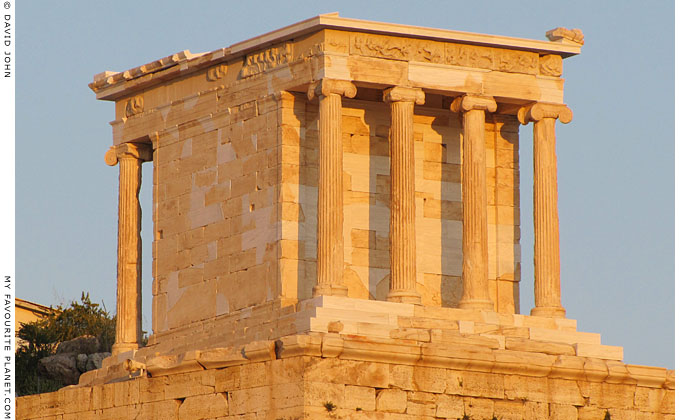
The Temple of Athena Nike following its most recent restoration, completed September 2010. |
Temple of Athena Nike part 1
Athena Nike's temple:
the Classical in miniature |
| |
The Temple of Athena Nike (Greek: Ναός Αθηνάς Νίκης) is a small, elegant Ionic temple designed by the architect Kallikrates (Καλλικράτης), one of the designers of the Parthenon, and built entirely of Pentelic marble between 427 and 421 BC.
It stands within the Sanctuary of Athena Nike on a 6 metre high stone platform extending from the southwest corner of the Acropolis. This bastion, which was known as a pyrgos (tower), dates back to at least the Bronze Age. From Classical times the sacred precinct was entered through the south wing of the Propylaia and by steps on the north side of the bastion (see the plan of the entrance to the Acropolis on gallery page 10 and a drawing of the steps on gallery page 8).
Kallikrates' Classical temple replaced the 6th century BC Archaic temple which had been destroyed by Xerxes' Persian army in 480-479 BC. Excavations of the bastion have revealed parts of two Archaic buildings, the base of a cult statue and a block from an altar bearing the inscription "Altar of Athena Nike. Erected by Patrokles". These finds have been dated to 580-530 BC, which corresponds with a religious revival and the rebuilding of the Acropolis in the second quarter of the 6th century BC, and to reforms to the Panathenaic festival in 566 BC.
There is also archaeological evidence that a naïskos (ναΐσκος, small temple) of poros stone and two altars were built here around 465-435 BC, between the time of the destruction of the old temple and the building of the new, and that these may have been preceded by wooden constructions.
The form of the temple is known as amphiprostyle, i.e. with porticos at either end, in this case each supported by four columns (tetrastyle). [1] The amphiprostyle was unusual in Greek temples, the peristyle (with colonnades all around, as in the Parthenon) being generally preferred. However, the use of the style here was an elegant solution to the problem of confined space on the bastion.
The Ionic columns are monoliths, carved from single pieces of marble, with a height of 406.4 cm [2] from base to capital, a diameter of 55.9 cm and 24 flutes. The temple was the first purely Ionic building on the Acropolis, as previously only the Doric order had been used; the Propylaia, a secular building begun ten years earlier, incorporated both Doric and Ionic columns. In front of the temple, to the east, stood an altar for sacrifices.
The cella or inner chamber, which was 3.78 x 4.19 metres (see a plan of the temple below), housed a xoanon (ξόανον), a cult statue of Athena Nike (Ἀθηνᾶ Νίκη, Athena Victory, see photo below), possibly seated, holding a helmet in her left hand and a pomegranate the right. [3] The pomegranate (Greek σίδη) is usually taken to have been a traditional symbol of fertility, but also of death and the seasons (stemming from the myths concerning Demeter, Persephone and Hades). However, in the case of this cult its exact significance is unknown. [4]
It is thought that her sacred image may have pre-dated the Persian destruction, possibly made at the same time as the earlier temple, and was removed to safety before Xerxes attacked Athens. According to this theory, it formerly stood on the Archaic base mentioned above and was then placed on a new pedestal in the Classical temple.
A frieze of low relief decorated the top each of the outer walls (see next page), and high relief sculptures, probably representing gods, adorned the pediments (the triangular shaped stones supporting the roof at each end of the temple). Only fragments of the pedimental sculptures have survived. There were also sculptures above each end and the centre of the pediments.
Around 410 BC a parapet (θωρακείοv, thorakion) of 1.05 metre high marble slabs was added to the north, west, and south edges of the bastion, decorated on the outer sides with reliefs of Nike leading sacrificial animals and holding trophies from victories. The most famous of these reliefs, in the Acropolis Museum, shows Nike apparently adjusting her sandal (see photo, above right). The reliefs have been attributed to Kallimachos and/or Paionios of Mende.
Holes in the top the slabs of the parapet suggest that it had a metal railing above it. |
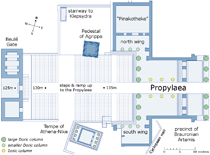
See plans of the entrance to
the Acropolis, showing the
position of the Temple of
Athena Nike and other
features on gallery page 10. |
| |
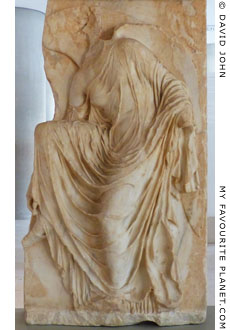
Marble relief of Nike adjusting
her sandal, known as
«Σανδαλίζομἐνη» Νίκη
(the Sandalbinder), from the
south parapet of the Athena
Nike bastion. Circa 410 BC.
Height 105 cm.
Acropolis Museum, Athens.
Inv. No. Acr. 973. |
| |
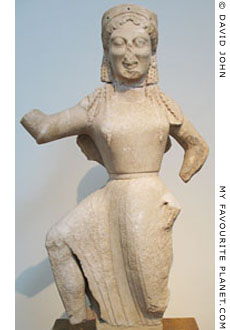
Archaic statue of Nike from
Delos. Parian marble. The
earliest known free-standing
statue of a Nike, probably by
Archermos of Chios,
circa 550 BC.
National Archaeological Museum,
Athens. Inv. No. 21. |
| |
| |
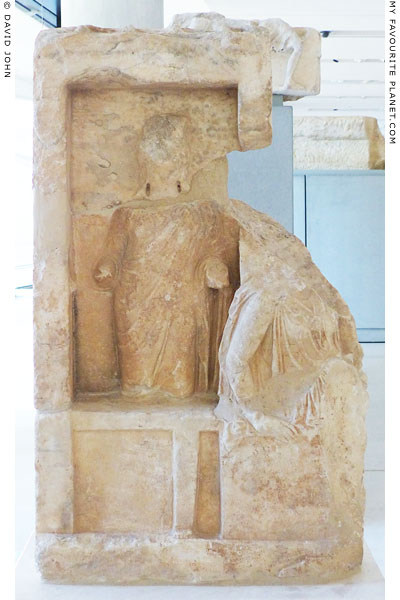
Marble votive relief, around 420 BC, thought to represent the cult
statue (xoanon) of Athena Nike in a naiskos (small temple), perhaps
the earlier temple of Athena Nike. In front of the statue is a table
for offerings, and to the right, Athena sits, as if resting after battle,
holding with her right hand her shield which stands on the ground.
Acropolis Museum. Inv. No. Acr. 2605+ |
| |
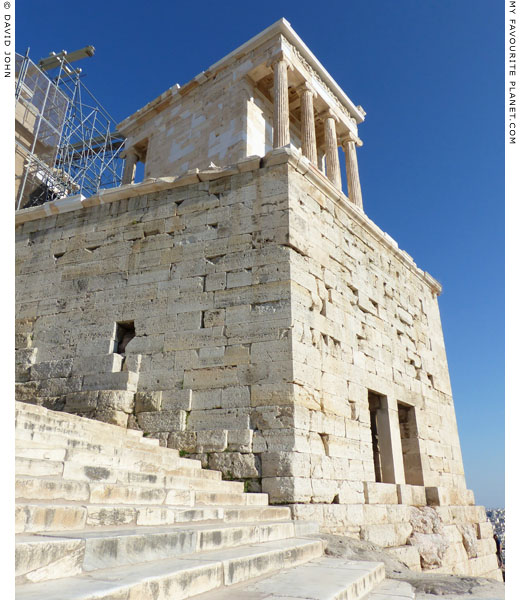
The bastion of the Temple of Athena Nike from the northwest.
|
The bastion was constructed of ashlar masonry in the late 5th century BC, to support the new temple and sanctuary. During excavations, it was discovered that the bastion was built over earlier constructions dating as far back as the Mycenaean period, on the natural outcrop of the Acropolis rock.
At the foot of the west face of the bastion (right) is a window-like niche (see below). To the north of the bastion (left) is the stairway up to the Propylaia, originally built during the Roman period, around 52 BC, and first reconstructed in the 19th century.
It is from this bastion that the legendary King Aegeus, father of Theseus the Minotaur slayer, is said to have leaped to his death, as the 2nd century AD travel writer Pausanias tells us:
"On the right of the gateway [Propylaia] is a temple of Wingless Victory. From this point the sea is visible, and here it was that, according to legend, Aegeus threw himself down to his death.
For the ship that carried the young people to Crete began her voyage with black sails; but Theseus, who was sailing on an adventure against the bull of Minos, as it is called, had told his father beforehand that he would use white sails if he should sail back victorious over the bull. But the loss of Ariadne made him forget the signal. Then Aegeus, when from this eminence he saw the vessel borne by black sails, thinking that his son was dead, threw himself down to destruction. There is at Athens a sanctuary dedicated to him, and called the hero-shrine of Aegeus." [5] |
|
|
| |
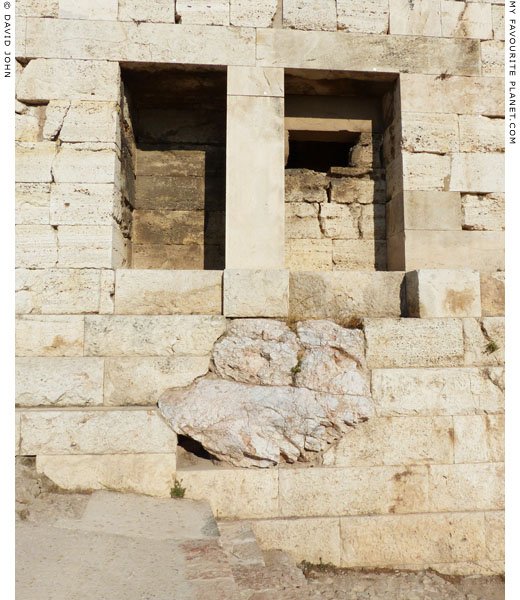
The window-like niche at the foot of the west face of the Athena Nike bastion.
|
Described as "two niches", a "double" or "bipartite" niche, the single space in the facade of the bastion is divided at the front by a central pier. Directly behind the back wall of the niche are the remains of a Mycenaean niche which has been partly exposed by archaeologists. The purpose of the niche or what may have been kept or displayed in it are unknown, but the existence of the earlier construction suggests a very ancient tradition, perhaps related to a cult.
Part of the natural rock potrudes from the ashlar masonry below the niche. The pathway beneath the bastion leads northwards (to the right) down from the area below the Propylaia to the North Slope and the Peripatos circuit path around the foot of the Acropolis. |
|
|
| |
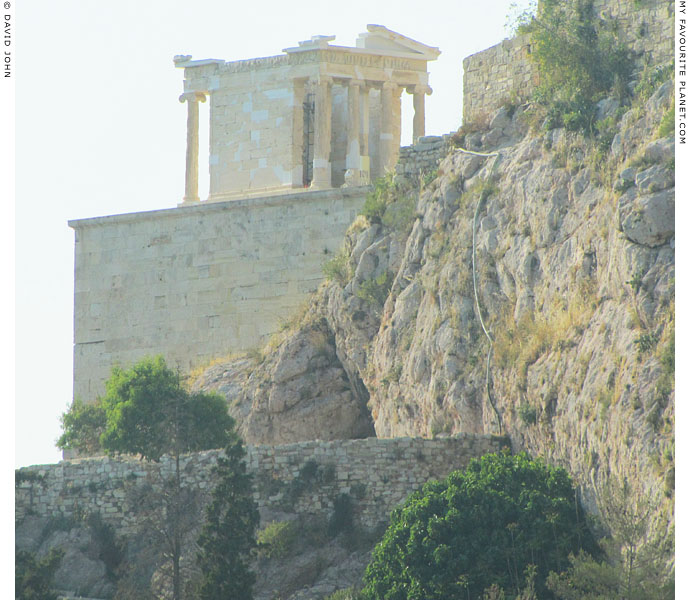
The front of the Temple of Athena Nike from the southwest slope of the Acropolis. |
| |
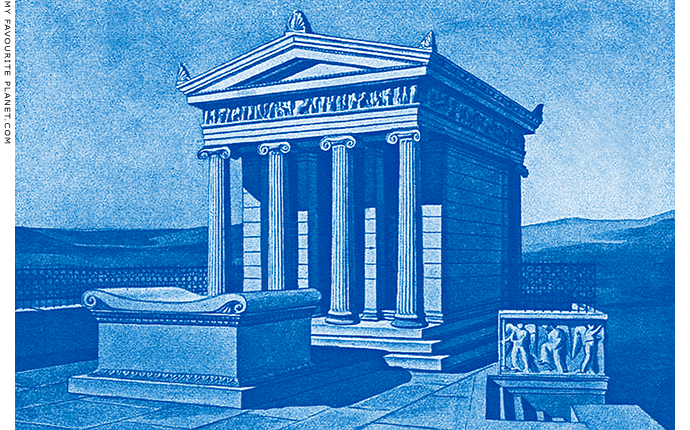
Late 19th century reconstruction of the Temple of Athena Nike, showing the altar before the temple,
the paprapet and the frieze with reliefs of Nike, and the top of the stairway up to the bastion (right).
See another illustration showing the stairway up to the bastion on Acropolis gallery page 8.
Illustration after Adolf Michaelis. Published in Hermann Luckenbach, Die Akropolis von Athen,
page 17. R. Oldenbourg, Munich and Berlin, 1905. At Heidelberg University Library. |
| |
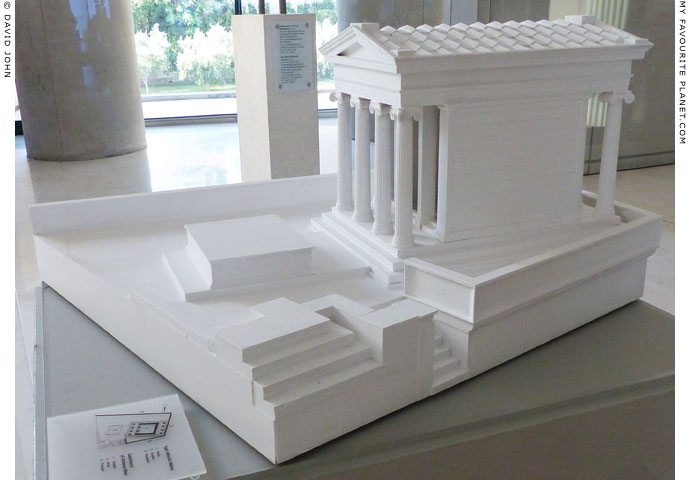
Model of the Temple of Athena Nike in the New Acropolis Museum, Athens.
Reconstruction by the Skulpturhalle Museum, Basel, Switzerland. Scale 1:20. |
| |
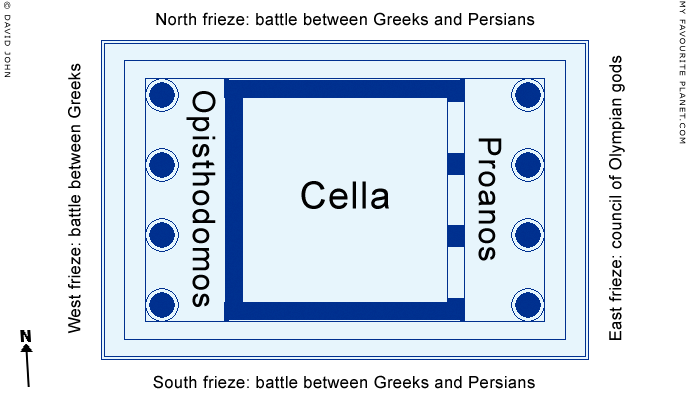
Simplified plan of the Temple of Athena Nike. |
| |
The base of the temple (stylobate) on which the steps stand measures 8.17 x 5.40 metres, and the cella in which the cult statue of Athena Nike stood 3.78 x 4.14 metres.
The six Ionic columns (see image below), made of single pieces of marble, have 24 flutes, are 406.4 cm high from base to capital, 55.9 cm in diameter, with a space of 1.03 metres between them.
See more about the friezes of the temple on the next page.
In plan and design this temple is very similar to the contemporary, slightly larger "Ilissos temple", built around 435-430 BC, which stood on the south bank of the River Ilissos, to the south of the Acropolis (See image and information below).
Source of illustration, right: T. Thomas Roger Smith and John Slater, Architecture, Classic and Early Christian. Searle and Rivington, London, 1882. At Project Gutenberg. |
|
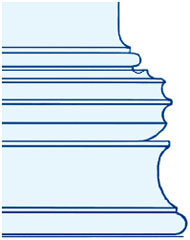
Section of an Ionic
column base of the
Temple of Athena Nike. |
|
| |
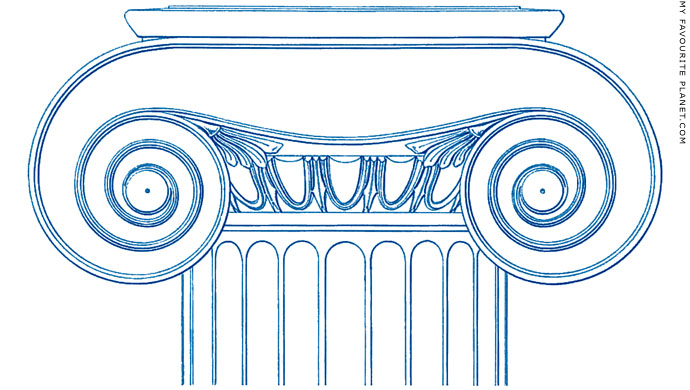
Reconstruction drawing of an Ionic capital of the Athena Nike Temple,
made by Hans Christian Hansen during the first reconstruction 1835-1836.
From Ross, Schaubert and Hansen, Die Akropolis von Athen nach den neuesten Ausgrabungen,
Erste Abtheilung: Der Tempel der Nike Apteros, plate IV. 1839. See gallery page 12, note 6. |
| |
Temple of
Athena Nike
part 1 |
Athena Nike |
|
 |
|
In other places in Greece winged Nike was the divine bringer of victory in war and sport as a separate goddess (see the statue of Nike of Samothraki and photos below). However, the Athenians appear to have assigned this function to their own chief deity Athena, and Victory became one of her many attributes or titles, as in Athena Polias (of the City), Athena Areia (the Warlike) and Athena Ergane (the Worker), as patroness and protector of various crafts, professions and endeavours. [6] Pausanias tells us that there was also a sanctuary of Athena Nike at Megara, northern Attica [7], and dedications were also made to her at Delos, Rhodes and Erythrai (Ionia; today Ildiri, near Çeşme, Turkey).
That Nike was also revered in her own right at Athens from at least the 5th century BC can be seen from other images of her found around the city, including a head and a statue of her discovered in the Ancient Agora (see photos below).
Nike herself is thought by some scholars to have been a daemon who only later came to be considered as a goddess, a belief which reached its height in the Hellenistic period and continued by the Roman worship of her as Victoria. It may be significant that there are no known myths in which she is a main protagonist; she always plays a supporting role, for example as the chariot driver for Zeus. She was closely associated with both Athena and Zeus, and there are statues of these major deities accompanied by a diminutive, and presumably subordinate Nike. Pausanias described the enormous statue of Athena Parthenos by Pheidias, which stood in the Parthenon:
"The statue of Athena is upright, with a tunic reaching to the feet, and on her breast the head of Medusa is worked in ivory. She holds a statue of Victory about four cubits high, and in the other hand a spear." [8] |
|
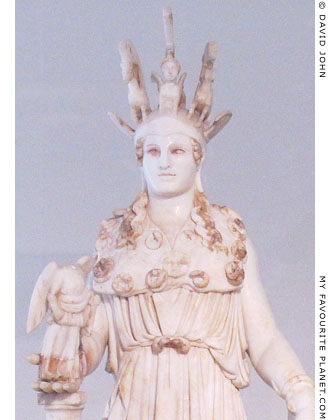
"The Varvakeion statuette" of Athena
Parthenos holding Nike in her right hand.
Roman period copy of the statue by
Pheidias, circa 447-439 BC, which stood
in the Parthenon. See gallery page 13.
National Archaeological Museum, Athens.
Inv. No. 129. |
|
| |
Was Athena Nike considered a single entity, somehow separate from either Athena or Nike? If so, how was she viewed as a personality or personification? And what was her relationship with other gods and humans? Who prayed to her, and what did they hope from her? The ancient Greeks - who were usually very imaginative about such matters - remain strangely silent.
It seems almost impossible to reconstruct the mindset of ancient Greek polytheism with its plethora of local and pan-Hellenic myths, legends and cults, families of gods, semi-gods, heroes, daemons, nymphs, maenads and other fabulous creatures. There are parallels in Hinduism and ancient Egyptian religion, but even Herodotus was not entirely successful in his attempts at equating the gods and divine genealogies of Egypt with those of Greece. Although the Greeks had no holy scriptures, around 700 BC Hesiod had attempted to assert literary order on the chaos of myths in his Theogony, and many Greeks surely took this work as gospel.
Little, in fact, is known about the history, nature or functions of the Athena Nike cult. There are very few references to it in ancient literature, inscriptions and art, but even this slim body of evidence provides subjects for several debates among scholars. How old was the cult? How, when and where did it start, and when was it introduced to the Acropolis? What were its ceremonies and rituals and its significance to Athenian life and religion, particularly the Panathenaic festival?
Once again, the only surviving primary literary source concerning the temple is the second century AD travel writer, Pausanias, and even he did not claim to have actually looked inside the temple or to have seen the statue. In his description of the way up to the Acropolis he merely states, "On the right of the gateway is a temple of Wingless Victory", before going on to relate the legend of Aegeus' suicide (see above). It is not until Book III of his Description of Greece that he mentions the statue while comparing it to another cult figure in Sparta:
"Near is a temple of Hipposthenes ... Opposite this temple is an old image of Enyalius [Ares] in fetters. The idea the Lacedaemonians express by this image is the same as the Athenians express by their Wingless Victory; the former think that Enyalius will never run away from them, being bound in the fetters, while the Athenians think that Victory, having no wings, will always remain where she is.
In this fashion, and with such a belief have these cities set up the wooden images." [9]
We must remember that Pausanias was writing over 500 years after the building of the temple. His references to Athena Nike as "Wingless Victory" (Νίκη Ἄπτερος, Nike Apteros) suggest either that he was ignorant of the cult or that this is how the Athenians themselves had come to understand it. Does this mean that the ancient belief had been abandoned, forgotten or modified, or merely that some Athenians had given her this nickname? And did he deduce the idea himself that they had removed Nike's wings to prevent her from leaving the Acropolis, or was this another legend or old wives' tale which had become current in the city?
The statue from the temple has been lost, though the reliefs of Nike around the parapet of the bastion, which Pausanias can not have failed to see as he passed by on the way up to the Propylaia, show her with wings.
Pausanias is thought to have been quite strict in using the word "xoanan" to mean "wooden image", which is how it is also usually translated when referring to the statue of Athena Nike. However, it has been suggested by Ira S. Mark (see reference in note 3 below), that if he had not in fact seen this statue then he was relying on the description by another author, such as Heliodoros the Periegete (note 2) who did not use the word in this strict sense. Mark argues that the statue could have been of marble rather than wood.
The photos, above right, show details of the so-called "Berliner Göttin" (Berlin Goddess), an Archaic marble statue from Keratea, Attica, dated to 580-560 BC, and therefore contemporary with the earlier temple of Athena Nike. Although the figure is known as a goddess, it is thought to be a funerary statue of a woman from a wealthy family presented as the bride of Hades, god of the underworld. The fruit she is holding appears to be a pomegranate, which was associated with the myth of Hades and Persephone.
The photo, below right, shows the so-called "Göttin von Tarent" (the Goddess of Tarentum), from Tarentum or Locri, southern Italy, dated to 475-450 BC, one of several known cult images of enthroned goddesses. Unfortunately, her hands are missing so that we do not know what she was holding, and there are no other clear attributes to identify the deity. It is thought that she may represent Persephone, Hera or Aphrodite. |
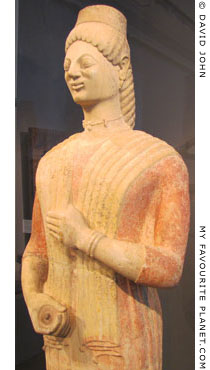
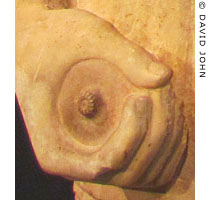
The "Berlin Goddess"
(Berliner Göttin), an Archaic
marble statue, from Keratea,
Attica, of a woman holding
a fruit as an offering to a
deity, possibly Hades.
580-560 BC.
Altes Museum, Berlin. |
| |

pomegranate |
| |
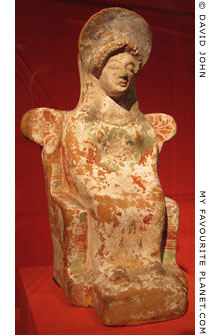
Enthroned Athena.
Ceramic votive statuette,
dedicated to Athena.
Athens, early 5th century BC.
Pergamon Museum, Berlin. |
| |
| |
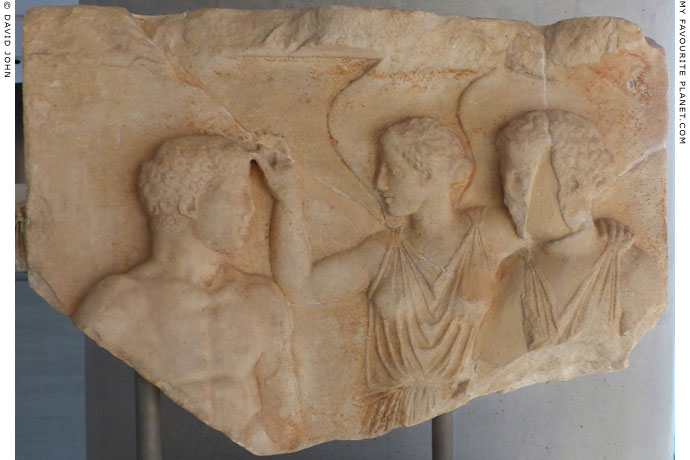
A dedicatory relief from the Acropolis of a winged Nike crowning Herakles or
a victorious athlete, and with her left hand on Athena's shoulder. 420-410 BC.
Acropolis Museum, Athens. Inv. No. Acr. 1329. |
| |
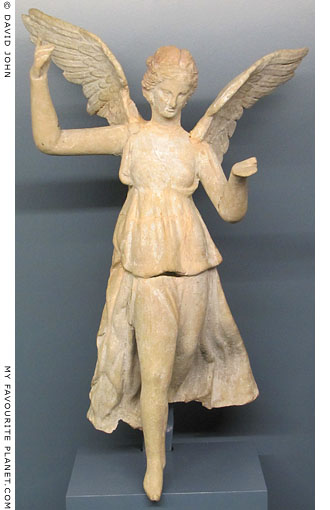
Terracotta statuette of winged Nike flying.
From Myrina, near Pergamon. 200-150 BC.
Antikensammlung SMB, Berin. Inv. No. TC 8192. |
| |
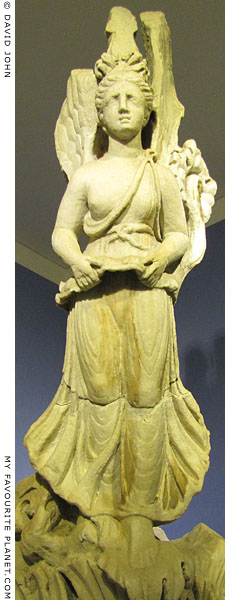
Statue of winged Nike from
an akroterion (roof decoration)
in the Pergamon Asclepieion.
Roman period, 2nd century AD.
Bergama Archaeological
Museum, Turkey. |
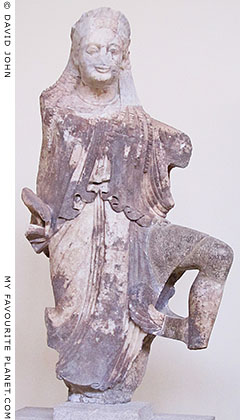
Marble statue of winged Nike
from the akroterion of the Archaic
temple of Apollo in Delphi. She is
shown in the conventional running
position and has wings attached
to her lower left leg. 515-505 BC.
Delphi Archaeological Museum. |
|
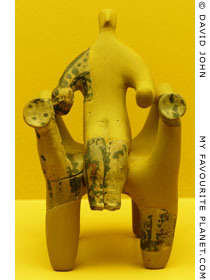
Terracotta statuette of a
deity seated on a throne,
holding a fruit, perhaps
a pomegranate.
From the Ancient Agora,
Athens, Geometric period.
Agora Museum, Athens. |
| |
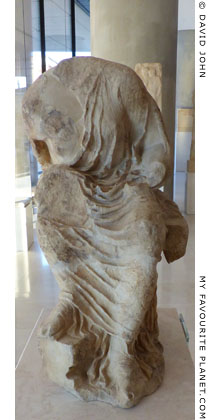
Statue of a seated goddess
from the Acropolis, thought
to represent Aphrodite
Pandemos who was
worshipped on the west
slope of the Acropolis.
Late 5th century BC.
Acropolis Museum, Athens.
Inv. No. Acr 7795+. |
| |
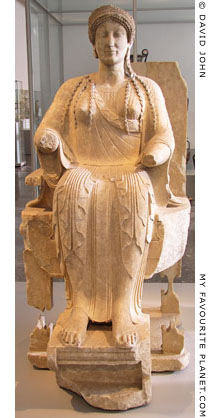
"The Goddess of Tarentum".
Marble cult statue of an
enthroned goddess, perhaps Persephone, from Tarentum,
Italy. 480-460 BC.
Altes Museum, Berlin.
Inv. No. Sk 1761. |
| |
| |
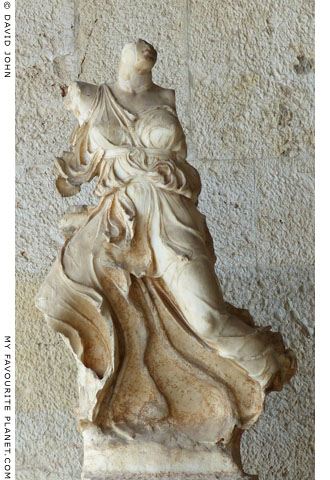
A fragmentary marble statue of winged Nike
flying to the right. Akroterion from the Stoa
of Zeus Eleutherios in the Ancient Agora
of Athens. Attributed to Kallimachos.
Circa 400 BC. Pentelic marble.
Height with plinth 129 cm.
Discovered at the site of the stoa on 21 March
1933 by archaeologists of the American School
of Classical Studies in Athens (ASCSA).
Agora Museum, Athens. Inv. No. S 312. |
|
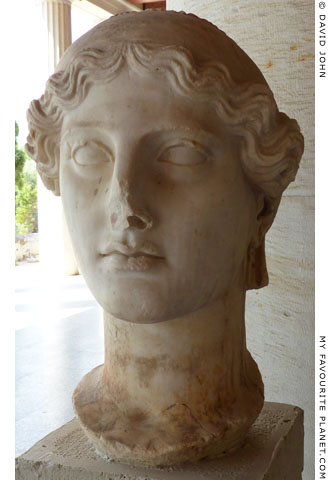
Marble head of the "Hertz head type" from
a statue of Nike, found in the Athens Agora.
2nd century AD. Found 31 July 1970, during
excavations by John McK. Camp II, in a well
(Deposit P 21:2) in the east colonnade of
the peristyle of a large late Roman complex
known as Roman House H, on the slope of
the Areopagus, south of the Athens Agora.
Pentelic marble. Height 41.7 cm.
Previously thought to be a copy of the
"Nike of Paionios" statue by Paionios in
Olympia, around 425-420 BC, but is perhaps
a copy of Nike from the Athena Parthenos
statue by Pheidias, around 450-430 BC.
Agora Museum, Athens. Inv. No. S 2354.
Among other ancient objects found in
the well was a marble head of Helios. |
|
| |
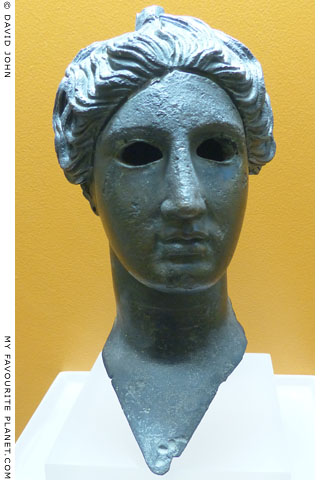
Bronze head of Nike from the Ancient Agora,
Athens. 420-415 BC. Thought to be one of
the series of "Golden Nikai" made in the time
of Perikles. Part of the Athenian state gold
and silver reserves was hammered into
sheets which covered statues or busts of
Nike. In the case of financial necessity the
sheets could be removed and made into coins.
Agora Museum, Athens. Inv. No. B 30. |
|
| |
Temple of
Athena Nike
part 1 |
The temple, democracy
and the priestess |
|
 |
|
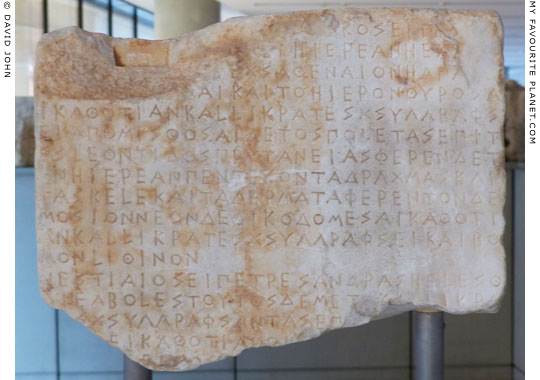
The obverse side of the marble stele with decrees concerning the Temple
of Athena Nike, found on the north slope of Acropolis in 1897.
The decree, from about 427-424 BC, orders that a priestess of Athena Nike
be chosen from among all Athenian women. Her salary is to be fifty drachmas plus
the legs and hides of publicly sacrificed animals. A door for the sanctuary as well as
a temple and stone altar are to be built according to the specifications of Kallikrates.
Inscription IG I³ 35. Athens Epigraphical Museum. Inv. No. EM 8116.
Now in the Acropolis Museum, Athens. |
| |
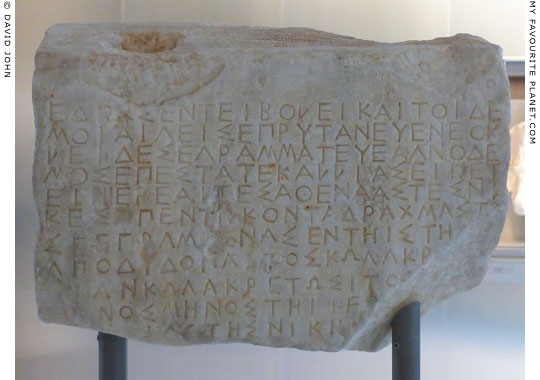
The inscription on the reverse side of the decree stele orders,
or reminds, officials to pay the priestess of Athena Nike the
fifty drachmas salary mentioned on the front of the stele.
Inscription IG I³ 36. Athens Epigraphical Museum. Inv. No. EM 8116.
Now in the Acropolis Museum, Athens. |
| |
The marble stele from the Athens Epigraphical Museum, currently in the Acropolis Museum, dated to the 440s or 420s BC (perhaps 427-424 BC), is inscribed with a decree concerning the appointment of a priestess and construction of a temple for Athena Nike:
"[name lost] proposed. A priestess for Athena Nike... shall be appointed from all Athenian women, and a door shall be built for the shrine in accordance with the specifications of Kallikrates. The leasing officials shall contract out the work in the prytany of Leontis. The priestess shall receive fifty drachmas and the legs and skins of public victims [sacfrificed animals]. And a temple and a stone altar shall be built in accordance with the specifications of Kallikrates."
Athens Epigraphical Museum. Inv. No. EM 8116.
Inscription IG I³ 35.
On the reverse side of the stele a later additional decree was inscribed 424/3 BC:
"Gods.
Resolved by the Boule and the demos: Aigeis held the prytany, Neokleides was Secretary, Hagnodemos presided, Kallias made the motion. To the Priestess of Athena Nike fifty drachmas. The fifty drachmas which have been written down on the stele shall be paid annually by the kolakretai [financial officials], whoever hold the office, in the month of Thargelion to the Priestess of Athena Nike."
Athens Epigraphical Museum. Inv. No. EM 8116.
Inscription IG I³ 36.
The Myrrhine epitaph and the Myrrhine lekythos
A further stele, nearly a metre high, was discovered during the 1940s in the Athens suburb of Zographou (3 km east of Syntagma Square), at the foot of Mount Ymittou (photo, right). It has been dated to the end 5th century BC, and is thought to be a funerary monument to the first priestess of the Temple of Athena Nike named as Myrrhine (Μυρρίνε, Myrtle). This stele has been associated with the "lekythos of Myrrhine", a funerary vase found in Syntagma Square and now in the National Archaeological Museum, Athens [10] (see photo, below right).
The epitaph of two epigrams, consisting of three couplets in the Ionic alphabet, is inscribed in stoichedon, 12 letters to a row in 16 lines (see image below).
Καλλιμάχο θυγατρὸς τηλαυγὲς μνῆμα <τόδ’ ἐστίν>,
ἣ πρώτη Νίκης ἀμφεπόλευσε νεών·
εὐλογίαι δ’ ὄνομ’ ἔσχε συνέμπορον, ὡς ἀπὸ θείας
Μυρρίνε ἠκλήθη συντυχίας ἐτύμως.
πρώτε Ἀθηναίας Νίκες ἕδος ἀμφεπόλευσεν
ἐκ πάντων κλήρωι Μυρρίνη εὐτυχίαι
"Far-shining memorial of Kallimachos' daughter,
who was the first to watch over the temple of Nike.
Her name accompanied her glory, as by divine
good fortune she was rightly called Myrrhine.
She was the first to watch over the seat of Athena Nike.
(chosen) from all the Athenians by a fortunate lot, Myrrhine."
Athens Epigraphical Museum. Inv. No. EM 13132.
Inscription IG I³ 1330 (SEG xii. 80). [11]
The appointment of the priestess by the state could signify either that there was previously no priestess specific to this shrine (and therefore the cult may have been recently introduced here), or that the new democratic Athenian assembly was taking over a responsibility from a non-state body. The salary of 50 drachmas a year was hardly an enormous sum, since an unskilled workman's wage during the time of Pericles is estimated to have been one drachma a day. [12]
If, as believed, the first stele was erected as early as the 440s BC, it begs the question why did it take so long for Kallikrates to build the temple? It has been suggested that the reference to building a door for the shrine concerns the earlier interim naïskos. The delay in completing the present temple could have been due to priority given to other works on the Acropolis, particularly the construction of the Propylaia that must have turned this narrow end of the rock into an enormous building site.
Many scholars believe that Mnesikles originally planned a larger south wing for his Propylaia which would have encroached on the space of the Athena Nike precinct, and that a dispute over his plan may have arisen (see gallery page 6). It is also thought that Kallikrates was meanwhile busy with other projects, including the Parthenon (built 447-438 BC), his contract to build part of Athens' new defensive walls, and perhaps the very similar Ilissos Temple, less than a kilometre southeast of the Acropolis (see below).
Another reason for the delay could well have been the Peloponnesian War (431-404 BC), which is also held responsible for the supposed unfinished state of the Propylaia. The war itself was expensive in terms of human lives and economic resources, and Athens was forced to fight on several fronts around the eastern Mediterranean, against Sparta as well as revolting members of the Delian League, Athens' empire and major source of wealth and power. To make things worse, from 429-426 BC Athens was struck by an epidemic (often referred to as a plague) which is thought to have killed as many as a third of its population, including Pericles (429 BC), the prime mover in the Acropolis building programme.
Before and during the war Athens had no reserves in its state treasury and had to borrow money from the treasuries of its temples. In the eleven years from 433 to 422 BC, 28 talents, 3,548 drachmas and 2 obols were borrowed from the Temple of Athena Nike. [13] |
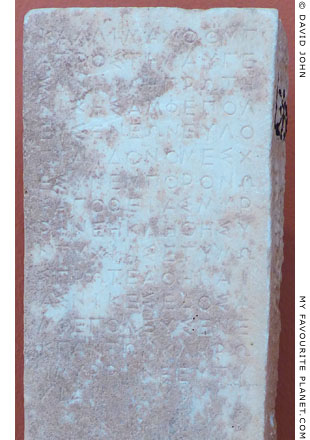
The top of a marble grave stele inscribed
with two epigrams for Myrrhine, the first
priestess of the Classical Temple of
Athena Nike. Around 410 BC.
Height 98 cm, width 17-18.2 cm,
depth 13 cm.
Only the upper part of the stele is
inscribed. It is thought it may have
been part of a larger monument.
Epigraphical Museum, Athens.
Inv. No. EM 13132.
Inscription IG I³ 1330. |
| |
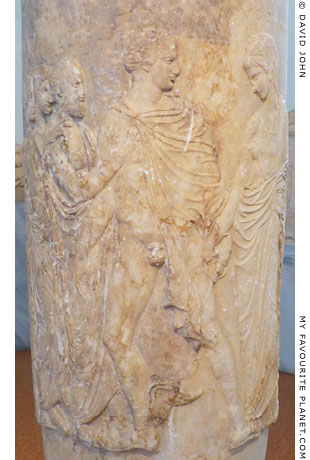
The Myrrhine lekythos.
Hermes Psychopompos (Guide of Souls)
leads the dead Myrrhine to the underworld.
On the left her relatives bid her farewell.
Marble, circa 420-410 BC. Height 136 cm.
National Archaeological Museum, Athens.
Inv. No. 4485. [9]
The vase is currently in Room 16
of the museum (August 2014).
See more photos below. |
| |
| The history of the Temple of Athena Nike continues on the next page > |
Temple of
Athena Nike
part 1 |
The Ilissos Temple |
|
 |
|
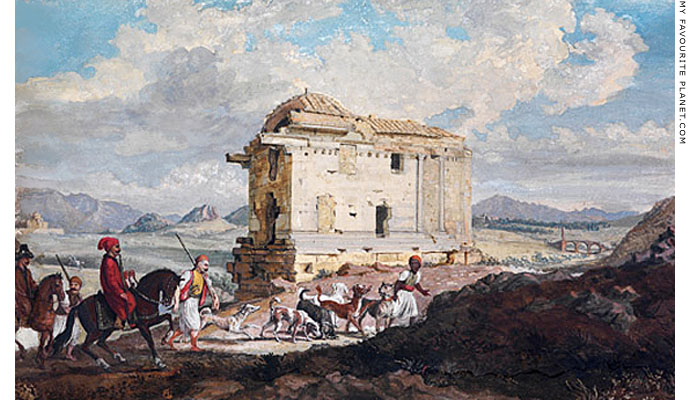
The remains of the Ilissos Temple in the mid 18th century.
Watercolour by James "Athenian" Stuart, made during his stay in Athens, 1751-1753.
|
The horse-rider dressed in red in the left of the painting is the Hassán Agà, the Vaiwode (or Voivode, Turkish governor) of Athens, out hunting with his attendants, servants and dogs.
Stuart included the local Turkish officials in several of his views of Athens. While wishing to please the Vaiwode and Disdar Aga (see gallery page 32), as his "hosts" in Athens, without whose permission investigation of the ancient monuments would have been impossible (or even more difficult than it actually became), he was also able to give his readership an impression of the conditions of social and political life in the city. Was his depiction of a hunting scene here a clever, punning reference to the temple as that of Artemis Agrotera, Artemis the Huntress? |
|
|
| |
The Ilissos Temple
Usually referred to today simply as the Ilissos Temple (or Ilissus; Greek, Ιλισός), this was the earliest known amphiprostyle tetrastyle temple in Greece, built high on the south bank of the Ilissos River around 435-430 BC, a few years before the Temple of Athena Nike. The similarities of the two temples have led to speculation that they were designed by the same architect, i.e. Kallikrates. It is thought to have been the Temple of Artemis Agrotera (Ο Ναός της Αγροτέρας Αρτέμιδος, translated variously as Artemis the Huntress, Artemis of the wildland or Artemis of the Fields) mentioned by Pausanias, and also to have been sacred to other deities such as Hecate and Demeter.
"Across the Ilissos is a district called Agrai and a temple of Artemis Agrotera. They say that Artemis first hunted here when she came from Delos [her traditional birthplace], and for this reason the statue carries a bow."
Pausanias, Description of Greece, Book I, Chapter 19, section 6. At Perseus Digital Library.
The temple was converted to a church, thought to have been dedicated to the Virgin Mary, "Our Lady on the Rock", perhaps as early as the 5th century AD, although by the late 16th century it had been abandoned. Four slabs of its sculptured frieze, taken as souvenirs by Morosini's army 1688, were later acquired by museums in Vienna and Berlin.
The rest of the building, little resembling its original form, survived long enough to be described by early modern visitors to Athens, such as Jacob Spon and George Wheler (1675), James Stuart and Nicholas Revett (1751-1753, Revett returned in 1765) and Julien-David Le Roy (1755), but in 1778 it was dismantled by the Ottoman Turks who used its stone to build fortifications.
Very little remains of the temple apart from the foundations, the parts of the frieze in the Kunsthistorisches Museum, Vienna and the Altes Museum Berlin, an Ionic capital in the British Museum, and some fragments found during recent excavations. Stuart and Revett's description, measurements and drawings have thus become an important source for scholars investigating not only this temple but also that of Athena Nike.
For further information about Spon, Wheler, Stuart and Revett see notes 1 and 2 on the next page.
A sign in the Athens district of Mets now marks the site of the temple's foundations on the south side of the busy Ardittou Avenue, which follows the course of the Ilissos River (which now runs underground), just west of the Panathenaic Stadium and south of the Temple of Olympian Zeus. When I last visited the foundations (August 2013) they were surrounded by a corrugated iron fence, but are visible from a stepped street next to them.
Further photos and information about the Ilissos Temple will be appearing in this guide at a later date, when we deal with that part of the city.
Save the Ilissos Temple
The foundations of the temple are in danger of being destroyed to make way for the building of private apartments. Local residents have been campaigning for several years to stop the building and save the temple's remains. For further information see the campaign's website artemisagrotera.org, in English and Greek.
Article: © copyright David John, Athens and Berlin, 2007-2014 |
|
|
| |

Lycian limestone block with a relief of Nike. Winged Nike, holding a victory weath in her left hand,
flies towards the left. Behind her a female figure holds a small round object (an offering of fruit?).
From Xanthus (Kinik), Lycia, Southern Turkey. Severe style, second quarter of the 5th century BC.
Istanbul Archaeological Museum. |
| |
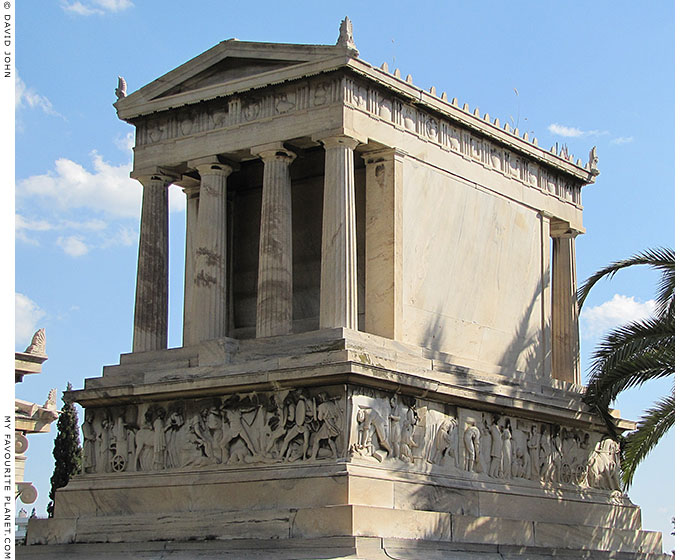
The grave of archaeologist Heinrich Schliemann (1822-1890),
discoverer of Troy, in the First Cemetery, Athens.
|
The upper part of Schliemann's mausoleum, designed by architect Ernst Ziller, is in the form of a temple similar to the Athena Nike Temple, in amphiprostyle (with porticos at either end) each supported by four columns (tetrastyle). However, the tomb has Doric rather than Ionic columns, and the entablature has triglyphs and metopes decorated with motifs of ancient pottery, rather than continous friezes. Ziller based the proportions of the columns, capitals and architrave on those of the Parthenon. The friezes around the bottom of the tomb depict scenes from Homer's Iliad (on the front and back) and Schliemann's archaeological exploits (along the sides).
Ziller's temple is similar in style to the The Oratory, in Liverpool, designed by John Foster Junior in 1829. See The Cheshire Cat Blog, Feb-March 2011.
|
|
|
| |
Temple of
Athena Nike
part 1 |
Notes, references and links |
 |
|
1. Amphiprostyle
See also The Cheshire Cat Blog, February-March 2011.
2. Height of Athena Nike Temple columns
According to the architect W. B. Dinsmoor, the height of the columns is 404.9 cm. (W. B. Dinsmoor, The Architecture of Ancient Greece, page 340. New York, 1950).
3. Statue of Athena Nike
The description is taken from the Suda or Souda (Σοῦδα), a Byzantine encyclopaedia of the ancient Mediterranean world, written in the 10th century AD.
"Athena Nike: Lykourgos in the speech On the priestess mentions her. That the xoanon of Nike, wingless, holding a pomegranate in her right hand and a helmet in her left, was worshipped by the Athenians Heliodoros the Periegete has shown in the first book of his On the Acropolis.
Alternatively she stands allegorically for the notion that even winning is completely dependent on thought; for thought contributes to victory, but being thoughtless and impetuous while fighting leads to defeat.
When she has wings she symbolizes that aspect of the mind that is sharp and, so to speak, swift-winged; but when she is depicted without wings she represents that aspect of it that is peaceful and quiet and civil, that by which the things of the earth flourish, a boon of which the pomegranate in her right hand is a representation. Just as the helmet in her left is a representation of battle. Thus she has the same capability as Athena."
See: Suda On-Line
Heliodoros the Periegete, Heliodoros Periegetes, also known as Heliodorus of Athens (Greek Ηλιόδωρος, Heliodoros, Gift of the Sun), a 2nd century BC Athenian author, thought to have written fifteen books on the Athens Acropolis around 150 BC. His works, now lost, were used as a source by several ancient authors, including Pliny the Elder and possibly Plutarch.
4. The statue of Athena Nike is usually described by modern writers as being made of wood. However, Ira S. Mark (see note 6 below) has made the plausible argument, based on more recent evidence, that it may have been marble. The prevailing idea that it was of wood is based on the strict interpretation of Pausanias' use of the word xoanon (ξόανον; plural, ξόανα, xoana; from the verb ξέειν, xeein, to carve or scrape) to mean a wooden image. The word is thought to have been originally used for primitive statues of wood, but later also for cult images in general, and Pausanias used it to mean cult statues, often without describing them or specifying the materials from which they were made.
Pausanias also wrote that at Olympia the sculptor Kalamis (working around 470-420 BC) made a statue of Nike as "Wingless Victory" (Νίκη Ἄπτερος, Nike Apteros), after the cult statue in the Temple of Athena Nike in Athens. Unfortunately, he did not say from which material the statue was made, although Kalamis is thought to have usually worked in bronze and marble.
"Near to the greater offerings of Micythus, which were made by the Argive Glaucus, stands an image of Athena with a helmet on her head and clad in an aegis. Nicodamus of Maenalus was the artist, but it was dedicated by the Eleans. Beside the Athena has been set up a Victory. The Mantineans dedicated it, but they do not mention the war in the inscription. Calamis is said to have made it without wings in imitation of the (wooden) image ["ξόανον", xoanon] at Athens called Wingless Victory."
Pausanias, Description of Greece, Book 5, chapter 26, section 6. At Perseus Digital Library.
5. The death of Aegeus
Pausanias, Description of Greece, Book 1, chapter 22, sections 4-5. At Perseus Digital Library.
Some scholars have challenged the idea that Aegeus threw himself from the bastion of Athena Nike, claiming this to be an incorrect translation of Pausanias' words. They claim he jumped into the sea.
"On the right hand of the Propylaia there is a temple of Victory without wings; from hence there is a prospect of the sea; and they report that Aegeus hurling himself into this sea, perished."
Taylor's Pausanias, v. i. p.61. Quoted by Edward Giffard, page 133 (Giffard's italics).
The pedants may be correct, but it somehow spoils the story: if Aegeus was so grief-stricken by the sight of the black sails that he rushed down to Faliron to drown himself, by the time he arrived there Theseus would have already been ashore to greet his father. On the other hand, the mythical convention that the Aegean Sea was named after this king of Athens seems to demand that he be drowned in it. Another version of the story has Aegeus throwing himself into the sea at Sounion.
6. Athena and Nike
In one of the few publications devoted to this temple, Ira S. Mark argues that the cult title Athena Nike is due to a "fusion", "annexation or assimilation of a preexisting local cult by a major god" rather than an epiphet of Athena. Mark has also observed that there is no direct evidence that Athena Nike was associated with victory in sport.
See: Ira S. Mark, The Sanctuary of Athena Nike in Athens: architectural stages and chronology. The American School of Classical Studies at Athens, 1993. At Google books.
A monograph presenting a detailed architectural study of the building's chronology and history, based on records from Nikolaos Balanos' dismantling and reerection of the temple 1935-1939.
The Athenians also ascribed to Athena the powers of healing normally associated with the goddess Hygeia (Health). There was an altar to Athena Hygeia on the Acropolis, just to the southeast of the Propylaia. A bronze statue to her was made by the sculptor Pyrrhos and commissioned, according to Plutarch, by Pericles, after the goddess appeared to him in a dream and told him how to heal a workman who had been injured during the building of the Propylaia. (Plutarch's Lives, Pericles, 13.7-8; see Acropolis gallery page 10, note 1.) The remains of the altar and the base of the statue have been discovered by archaeologists, and the base can be seen to right (south) of the Propylaia as you enter the Acropolis.
7. Sanctuary of Athena Nike at Megara
"The Megarians have a council chamber which once, they say, was the grave of Timalcus, who just now I said was not killed by Theseus. On the top of the citadel is built a temple of Athena, with an image gilt except the hands and feet; these and the face are of ivory. There is another sanctuary built here, of Athena Victory, and yet a third of Athena Aeantis (Ajacian)."
Pausanias, Description of Greece, Book I, chapter 42, section 4. English translation by W.H.S. Jones and H.A. Ormerod, in 4 Volumes. Harvard University Press, Cambridge, MA; William Heinemann Ltd., London, 1918. At Perseus Digital Library.
8. Statue of Athena Parthenos
Pausanias, Description of Greece, Book I, chapter 24, 7. At Perseus Digital Library.
9. Nike Apteros
Pausanias, Description of Greece, Book III, chapter 15, sections 7-8. At Perseus Digital Library.
Plutarch related a story that during Alexander the Great's seven month siege of Tyre in 332 BC, the inhabitants tethered a colossal statue of a god, referred to by the writer as Apollo, in order to prevent the deity from defecting.
"And many of the Tyrians dreamed that Apollo told them he was going away to Alexander, since he was displeased at what was going on in the city. Whereupon, as if the god had been a common deserter caught in the act of going over to the enemy, they encircled his colossal figure with cords and nailed it down to its pedestal, calling him an Alexandrist."
Plutarch, The Life of Alexander (Part 2 of 7), chapter 24, sections 6-7. Translated by Bernadotte Perrin. Plutarch, Parallel Lives, Loeb Classical Library edition, Volume VII, 1919. At Bill Thayer's LacusCurtius website, University of Chicago. |
|
|
| |
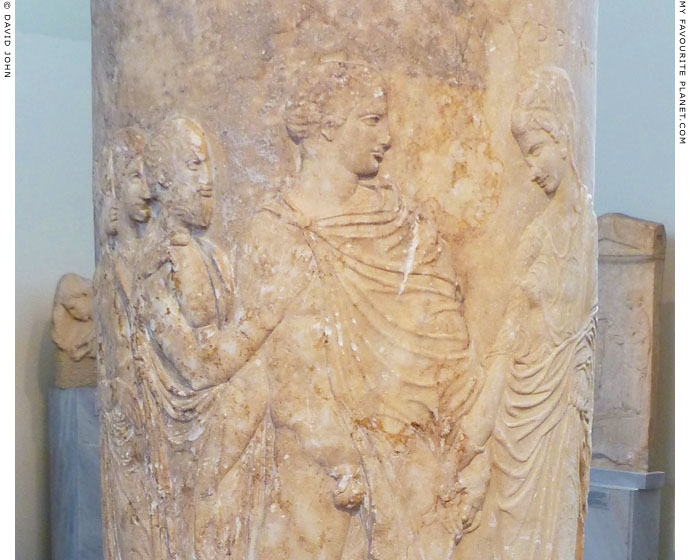
The Myrrhine lekythos. Hermes Psychopompos (Guide of Souls) leads the dead Myrrhine (right)
gently by the hand to the underworld. On the left her three relatives bid her farewell.
The bearded man (her father or husband?) holds up his right hand. Is he waving or
trying to hold Hermes back? The two figures behind him, one of whom rests in hand
on the old man's right shoulder, him appear to be young men (her brothers?).
|
10. The Myrrhine lekythos
See the photo (right) of the restored funerary lekythos in the National Archaeological Museum, Athens, and the detail showing the name "Myrrhine" inscribed over the head of the dead woman (below, right).
| |
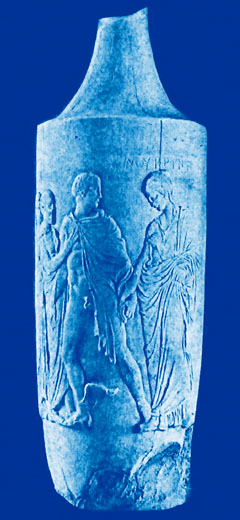
Early photo of the damaged lekythos,
taken shortly after its discovery,
before it was restored.
Source: Felix Ravaisson, Le monumente de Myrrhine et les bas-reliefs funeraires, Planche I. Typographie Georges Chamerot, Paris, 1876.
|
11. Inscriptions concerning the temple and priestess of Athena Nike
Another translation of the Myrrhine epitaph:
This is the conspicuous memorial of the daughter of Kallimachos who was the first to serve as attendant at the temple (νεών) of Nike. She had a name that was a companion to her good reputation, since she was aptly called Myrrhine by divine chance. Myrrhine was the first to serve the sanctuary (ἕδος) of Athena Nike and, out of all, she was chosen by the luck of the draw.
These inscriptions have been translated and interpreted in various ways. Some scholars argue that the line "She was the first to watch over the seat of Athena Nike" is not absolute proof that Myrrhine was either the priestess of this temple or the first of this cult. The notion that the priestess was literally chosen "by a fortunate lot" has also been questioned.
See; Julia Lougovaya-Ast, Myrrhine, the First Priestess of Athena Nike. In: Phoenix, Vol. 60,
No. 3/4 (Fall - Winter, 2006), Pages 211-225. Classical Association of Canada. At jstor.org.
Anyone with a special interest in this subject may also want to read some of the reviews of and counter-arguments to Ms Lougovaya-Ast's article.
In 1955 Greek archaeologist Ioannis K. Papadimitriou (also known as John Papademetriou; Greek, Ιωάννης Παπαδημητρίου; 1904-1963) suggested that the character Myrrhine in Aristophanes comedy Lysistrata, first performed in Athens in 411 BC, is a portrait of the first priestess of the Temple of Athena Nike. D. M. Lewis in Oxford went further, suggesting that Lysistrata herself may have been Lysimache, the priestess of Athena Polias (worshipped at the Erechtheion).
See: David Malcolm Lewis (1928-1994), Who was Lysistrata?, in Selected papers in Greek and Near Eastern history, Chapter 22, pages 187-202. Edited by Peter John Rhodes. Cambridge University Press, 1997.
12. Greek wages
See: Robert Flaceliere, Daily life in Greece at the time of Pericles, translated from the French by Peter Green. Weidenfeld & Nicolson, London 1965. Paperback edition, Phoenix Press, 2002. Page 130.
This book is an excellent primer for anyone interested in how the Greeks lived, loved, worked, fought, played and prayed during the time the Acropolis was being rebuilt.
13. Capital owed to Athena Nike
The list of sums of money owed to the temples of Athena Nike and Athena Polias, including the interest to be paid on the loans, is part of a document containing a detailed record for 426-422 BC and a summary for 433-426 BC.
See: Peter John Rhodes, The Greek city states: a source book; 225. Sacred treasuries lending money to the state, fifth century. Pages 138-139. Cambridge University Press, 2007. Preview at Google books.
(Quote from the original document, taken from: Meiggs and Lewis, Greek historical inscriptions, 72, 112-24.) |
| |
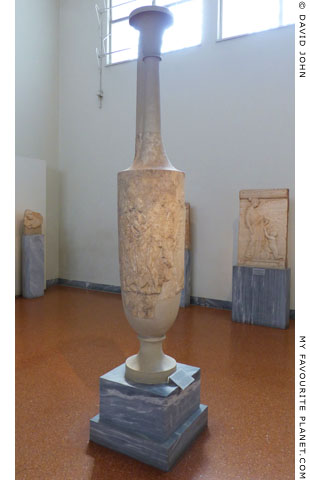
The Myrrhine lekythos restored,
with the addition of the modern
base, neck and handle.
National Archaeological Museum, Athens.
Inv. No. 4485. |
| |
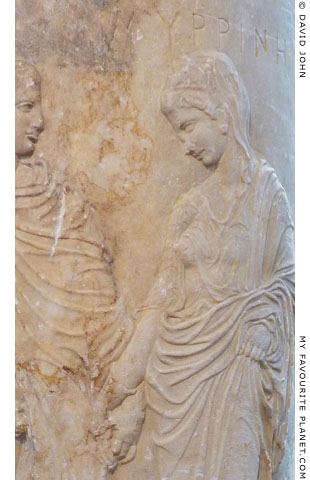
The name "Myrrhine" inscribed
over the head of the dead
woman on the funerary lekythos.
National Archaeological Museum, Athens.
Inv. No. 4485. |
| |
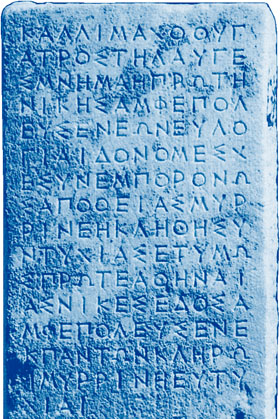
The epitaph of Myrrhine.
Epigraphic Museum, Athens. IG I³ 1330. |
| |
| |
Temple of
Athena Nike
part 1 |
Further reading |
|
 |
|
Emily de Bree, The interventions on the temple of Athena Nike. A study of restoration techniques and guidelines based on the interventions on the temple of Athena Nike on the Athenian Acropolis. (PDF document) Masters thesis in archaeology, May 2010. Department of Archaeology, History, Culture Studies and Religion, University of Bergen, Norway.
We mention this thesis first as a valuable, accessible and readable recent contribution to the literature on the Athena Nike temple.
H.B. Mattingly, The Athena Nike Temple Reconsidered. American Journal of Archaeology No. 86, 1982. Pages 381-385.
R.S.J. Garland, Religious Authority in Archaic and Classical Athens. The Annual of the British School at Athens, Vol. 79, 1984. Pages 75-123.
D. Giraud, Study for the restoration of the temple of Athena Nike. Volumes 1a and 1b.
Upourgeio Politismou, Epitropi Syntiriseos Minmeion Akropoleos, Athens, 1994.
The temple of Athena Nike: a brief description. Acropolis restorations: The CCAM interventions, 1994a. Edited by R. Economakis. Academy Editions, London. Page 179.
J. de Waele, The temples of Athena Nike on the Acropolis of Athens. Ancient measurements and design. Pharos, Journal of the Netherlands Institute at Athens, vol. 5, 1997. Pages 27-48.
D. Giraud, The restoration project of the temple of Athena Nike. Restoration of the Athenian Acropolis, 2003. Pages 134-137.
S. Gizzi, The temple of Athena Nike. Restoration of the Athenian Acropolis, 2003. Pages 128-133.
D. Michalopoulou, Technical issues and constructions in the restoration of the temple
of Athena Nike. The Acropolis Restoration News 4, 2004. Pages 18-20.
E. Lembidaki, On the occasion of the new restoration of the temple of Athena Nike: Looking back at the history of the cult statue of Athena Nike. The Acropolis Restoration News 7, 2007. Pages 24-27.
In Greek:
N. Balanos. H νέα άναστήλωσις του ναού της Αθηνάς Νίκης (1935-1939).
Αρχαιολογική Εφημερίς 1937, Part 3 [1956]. Pages 776-807.
In German:
L. Ross, E. Schaubert, C. Hansen, Die Akropolis von Athen nach den neuesten Ausgrabungen,
I. Der Tempel der Nike Apteros. Berlin, 1839.
A.K. Orlandos, Zum Tempel der Athena Nike. Mitteilungen des deutschen archäeologischen Instituts, Athenische Abteilung 40, 1915. Pages 27-44.
B. Wesenberg, Zur Baugeschichte des Niketempels. Jahrbuch des deutschen archäeologischen Instituts 96, 1981. Pages 28-54. |
|
|
Photos, illustrations, maps and articles: © David John,
except where otherwise specified.
Additional photos: © Konstanze Gundudis
All photos and articles are copyright protected.
Images and materials by other authors
have been attributed where applicable.
Please do not use these photos or articles without permission.
If you are interested in using any of the photos for your website,
project or publication, please get in contact.
Higher resolution versions are available on request.
My Favourite Planet makes great efforts to provide comprehensive and accurate information across this website. However, we can take no responsibility for inaccuracies or changes made by providers of services mentioned on these pages. |
|
| |
 |
Visit the My Favourite Planet Group on Facebook.
Join the group, write a message or comment,
post photos and videos, start a discussion... |
|
|
| |
|
|
| |
| |
 |
| |
 |
| |
 |
| |
 |
| |
 |
| |
 |
| |
George Alvanos
rooms in
Kavala's historic Panagia District
Anthemiou 35,
Kavala, Greece
kavalarooms.gr
|
| |
Olive Garden Restaurant
Kastellorizo,
Greece
+30 22460 49 109
kastellorizo.de
|
| |
Papoutsis
Travel Agency
Kastellorizo,
Greece
+30 22460 49 286
greeklodgings.gr
|
| |
|